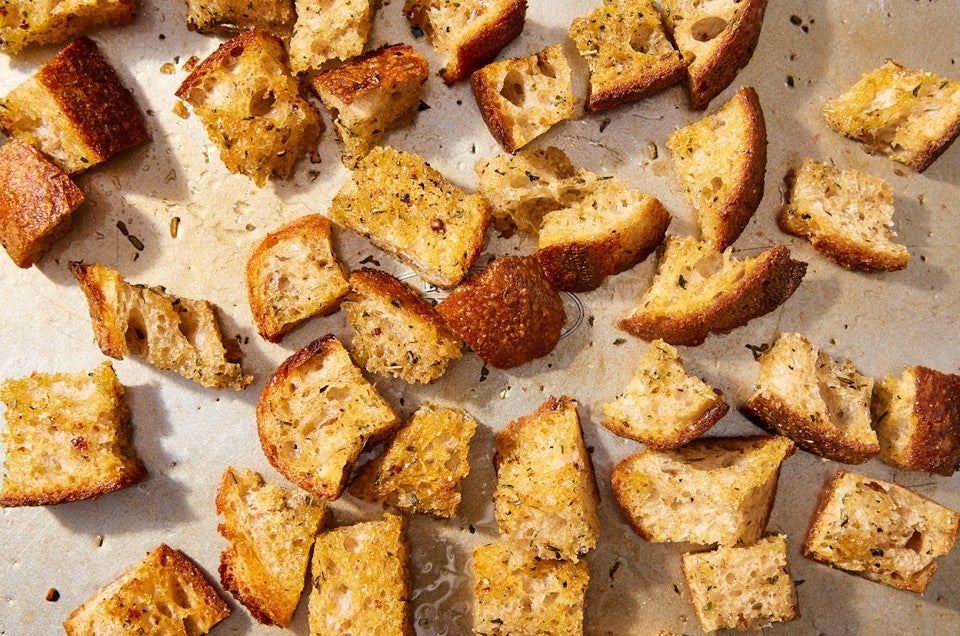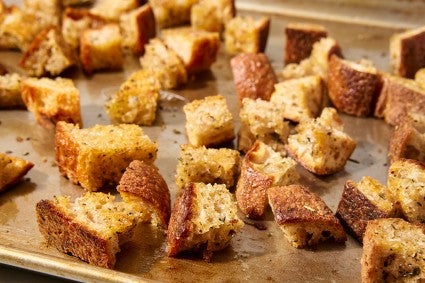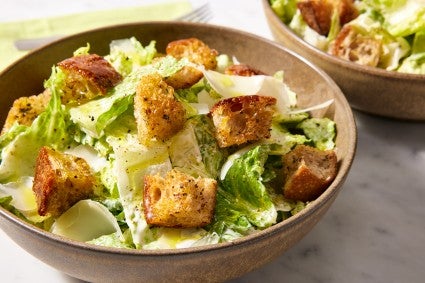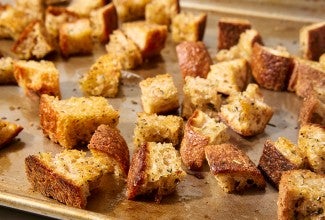


It’s an undisputed fact that croutons make any salad more delicious. They’re requisite for some salads (Caesar, I’m looking at you!) but an enhancement to all. They turn something compost bound (stale bread) into something marvelous, salty, and crunchy. And the best croutons are homemade croutons.
The other day I took a tour through the crouton section of my local grocery store. I was surprised when I looked at the unit price for a bag: $9.21 per pound! It’s outrageous, especially because store-bought croutons are really not very good, and because you can make exceptional croutons at home with few ingredients, minimal effort, and just a small amount of time. And once you’ve made the homemade version — from bread that started out delicious and, with the addition of fat, spices, and salt, only becomes more so — there’s no looking back.
While technically any bread can be croutoned, the character of the bread you choose is going to determine the resultant crouton. Enriched breads, like pain de mie and challah, toast more quickly because they contain sugar, and when fully dried they have an almost powdery quality. Breads with inclusions, like loaves with olives or nuts, will contribute those flavors to the finished crouton, which can be good or bad, depending on how you plan to use it. Sweet breads, like, say, cinnamon raisin, can be made into croutons, though the use case for a sweet crouton is perhaps more limited. My preference? A good all-purpose crusty loaf, like Pain de Campagne, which yields craggy croutons, or a simple sandwich loaf, which yields denser ones.
To be clear, I don’t bake bread in order to make homemade croutons; croutons are simply a byproduct of baking bread. I gather up the heels and stale slices in a bag in my freezer, and when that bag impedes the closure of the freezer door, I take it out, let the bread thaw, tear or cube it into bite-sized pieces, and make a batch of croutons.

Even in our own Test Kitchen, there’s debate about whether you should cube your bread into polite squares, or whether you should tear it into craggy, irregular pieces. I’m team tear because I like the textural variety those irregular pieces provide, and the way some bits get more browned than others and some stay a little softer and chewier, but you can choose your own adventure. In either case, avoid making your cubes or pieces too large; a crouton should fit on a fork with other salad ingredients, not be a bite unto itself.
To become delightfully crunchy and flavorful, a crouton requires some fat. You can use either melted butter or olive oil; croutons made with olive oil will keep longer (weeks) than croutons made with butter (days).
At minimum, homemade croutons should be seasoned with salt. But you can take a more maximalist approach: Herbes de Provence, Pizza Seasoning, za’atar, and garlic powder (or garlic salt) are all fair game. You can also infuse your butter or olive oil with some fresh herbs and garlic or spices: Heat the fat in a pan over low heat, add a sprig of rosemary or fresh thyme and a clove of peeled garlic, and let the mixture cook briefly over low heat until it smells good; fish out the garlic and herbs before drizzling the infused fat over your bread.

Once you’ve determined whether you’re team cubed or torn, team olive oil or butter, team salt or team salt plus other flavorings, the only thing left is to decide how to cook your croutons.
Yes, you can cook them in a frying pan on the stovetop, but that only works for small batches, and you have to pay hawkish attention, stirring them often so the croutons get evenly browned all over. Annoying!
Easier to just dump the fat-coated, seasoned bread onto a rimmed baking sheet and bake at 350°F until golden brown, crunchy on the exterior but still a bit soft within, stirring occasionally. This will take about 10 to 15 minutes, though the exact timing will depend of the type of bread you've used and how large your croutons are. Trust me on this last point: If you cook your croutons until they are crunchy all the way through, you’re going to end up with tooth breakers, because they’ll continue to crisp up as they cool. And that’s not a salad enhancement, it’s a liability.
Homemade croutons are less expensive than store-bought; they’re also ten times tastier. They enhance every salad on which they are sprinkled, and can also be used as a garnish for soups, or crushed with a rolling pin and sprinkled on pasta or used as a filling for an omelet.
And they tend to disappear fast; if I leave a pan of freshly baked croutons on the counter, half a batch seems to disappear from the baking sheet long before the salad is even made.
The best bread for croutons is the bread you have. But sourdough Pain de Campagne is a great daily bread. Watch Martin make it in this video.
Cover photography (Homemade Croutons) by Rick Holbrook; food styling by Kaitlin Wayne


